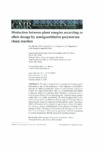Please use this identifier to cite or link to this item:
http://www.alice.cnptia.embrapa.br/alice/handle/doc/513749| Title: | Distinction between plant samples according to allele dosage by semiquantitative polymerase chain reaction. |
| Authors: | MARTINS, F. A.  CARNEIRO, P. C. S.   GUIMARAES, C. T.   MAGALHAES, J. V. D.   CARNEIRO, J. E. S.   CRUZ, C. D.   |
| Affiliation: | Francielle Alline Martins, Universidade Federal de Viçosa; Pedro Crescêncio Souza Carneiro, Universidade Federal de Viçosa; CLAUDIA TEIXEIRA GUIMARAES, CNPMS; JURANDIR VIEIRA DE MAGALHAES, CNPMS; José Eustáquio de Souza Caneiro, Universidade Federal de Viçosa; Cosme Damião Cruz, Universidade Federal de Viçosa. |
| Date Issued: | 2009 |
| Citation: | Genetics and Molecular Research, Ribeirão Preto, v. 8, n. 1, p. 319-327, 2009. |
| Description: | The lack of informativity of samples from heterozygotic individuals is one of the hindrances in the mapping of quantitative trait loci of outbred populations, since it is not normally possible to identify the origin of each allele. One way to include these individuals in analyses would be to genotype their endosperm, considering that heterozygote (Aa) has AAa endosperm, when the female genitor donates the A or a allele, respectivelly. We used semiquantitative polymerase chain reaction to determine allele dosages in DNA mixtures, by simulating the observed conditions for endospermic tissue. Semiquantitative polymerase chain reaction on agarose gels, along with regression analysis, allowed differentiation of the samples according to the amount of DNA. This type of information will help decrease the number of non-informative individuals in quantitative trait locus mapping of outbred populations, thereby increasing mapping accuracy. |
| Thesagro: | Milho Zea mays Genética vegetal |
| Type of Material: | Artigo de periódico |
| Access: | openAccess |
| Appears in Collections: | Artigo em periódico indexado (CNPMS)  |
Files in This Item:
| File | Description | Size | Format | |
|---|---|---|---|---|
| Distinctionbetween.pdf | 5,83 MB | Adobe PDF |  View/Open |









